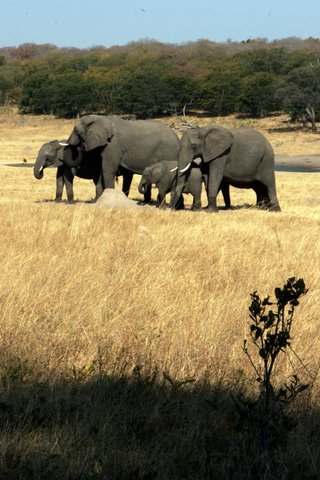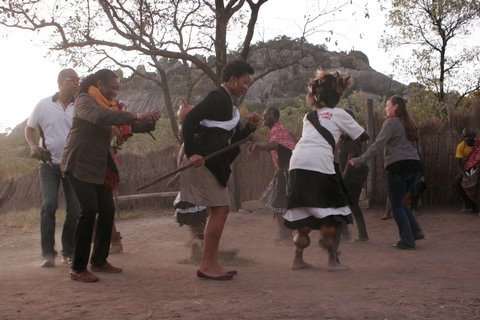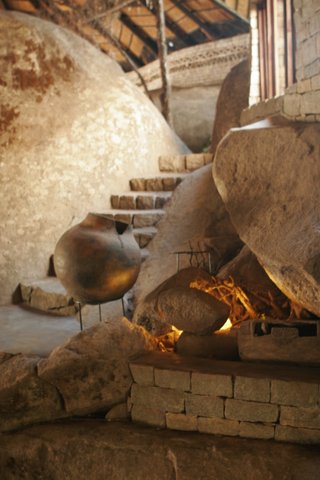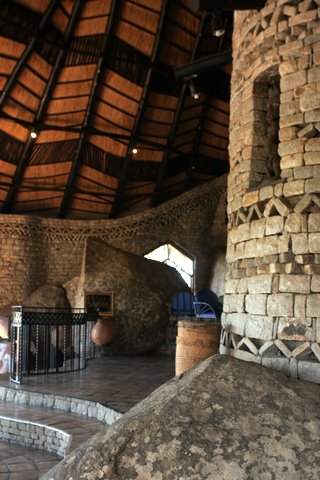A stone's throw from my luxury tent at "The Hide" safari camp near Harare, Zimbabwe, over two dozen elephants squirt water into their mouths and splash in the lake.
The night is so clear and moonless that the Milky Way looks painted in the heavens with whitewash and the Southern Cross hangs from above as in a celestial cathedral. Then, a male lion roars, cutting the air with its guttural voice. Sleep can wait until I return home. At this moment, the circle of life is chasing its tail right off my deck.
Unlike in many African countries, the wild animals in Zimbabwe are not held in by fences. The herds of wildebeest and kudu, impala and warthog, elephants and lions run free. They can often be seen munching on the golf course or roaming the lodges' back yards.
I have come to Zimbabwe partly for the animals, like nearly everyone who comes to Africa, and I found them at nearby Hwange National Park and this unique safari camp where guests can observe game from concealed "hides" by the animals' watering holes.
I've also come to see magnificent Victoria Falls, but while the cataract is a breathtaking sight to behold and shouldn't be missed, what I really want to learn about is the Zimbabwean people, for many consider them to be the friendliest on the continent. So to understand who they are today, I have to learn where they came from and so I pay a visit to Great Zimbabwe Monument, a World Heritage Site in Masvingo Province.
The Monument Complex
To access the ancient trail up to the rock fortress at the Great Zimbabwe ruins, one has to pass through the extremely narrow "Blood Passage." Long ago, to keep the riff raff out of the emperor's headquarters on the hilltop, a trick question was asked. If you weren't privy to the correct answer, a boulder was dropped on you from above, smashing your brains and bones to smithereens. Fortunately for us, our Zimbabwe historical guide, laughs; he's letting that part slide before we begin to ascend the stone steps.
There are three complexes to the Great Zimbabwe National Monument, the Hill Ruins, the Valley Ruins and the Great Enclosure, which the Shona people built back in 12-1500 AD. Over 150 sites of dry stone wall construction were made without mortar, encompassing huge granite boulders into the construction design. They built fires along the rock's crevasses and made the stone fracture into smaller pieces for use as stones in the construction. "Zimbabwe" means "house of stone" and it is the only country to glean its name from a cultural site.
The medieval palace perched on the acropolis was the "royal city"' The king of the Shona people lived here, who ruled all of south Africa at the time.
From these lofty heights, we can see into the Valley Ruins, where more than 25,000 people lived. This city was a great trading center, that once sent emissaries all the way to China. The Great Enclosure in the valley below is 200 meters in circumference and 7 meters in diameter. The king's wives lived within these walls, an entourage of more than 200, and ran a type of pre-marital school for young women. Here important lessons were shared on how to keep the King and Shona men, in general, happy. By 1450, the civilization had declined; the land could not support all the people and the colossal settlement was seemingly abandoned.
While we gaze out over the ancient settlement, we learn from our guide that the symbol of Zimbabwe is the fish eagle (hungwe) or osprey. This raptor knits the world of the sky together with the earth, as he dives into the rivers for his nourishment and rises back into the heavens.
The Zimbabwean People
As we descend the trail, I chat with my guide on what local foods would have been harvested back then, and also what he enjoys eating today.
"Mopane worms, I love them," he exclaims. The insect is really a caterpillar picked from the trees, their guts hand-squeezed out and then dried in the sun. "Throughout the year, we soak them, then stir fry them in oil. They are so very delicious. I eat them for supper 3 times a week but wish I could eat them every single day."
When I make a face, he's reminded that we Americans do not share their joy of insect eating, but he eggs me on by sharing his recipe for "Baked Baboon Head."
"You take the head, tie the jaw shut -- stuff tomatoes and chilies in its cavity, boil it and when the tomatoes ooze out the eyes, it's ready to eat!"
Once we walk through the Great Enclosure, we arrive at the Shona village where the local women dance with their gourds tied around their ankles. Loose seeds shake inside as they shuffle in the sandy dirt to the rhythm of the drummer. They come to my friends and take our hands, inviting us to join the circle and dance.
Tonight we are capping off our day of history by spending the night at the Great Zimbabwe Hotel (African Sun Hotels) located only minutes from the park. It was built as a replica of the national site, and as I walk its stone halls and community rooms, reminiscent of the stacked masonry at the Monument, it is a perfect fit for today's experience.
When I first told my friends and family I was coming to Zimbabwe, they asked if it was safe. But today the country is working hard to promote tourism. Disregarding politics, the people are focusing on sharing their land, their animals, their music and dance, their hearts with you. My guide and I laugh and share our lives over a dinner whose buffet does not contain mopane worms, I'm happy to say.





